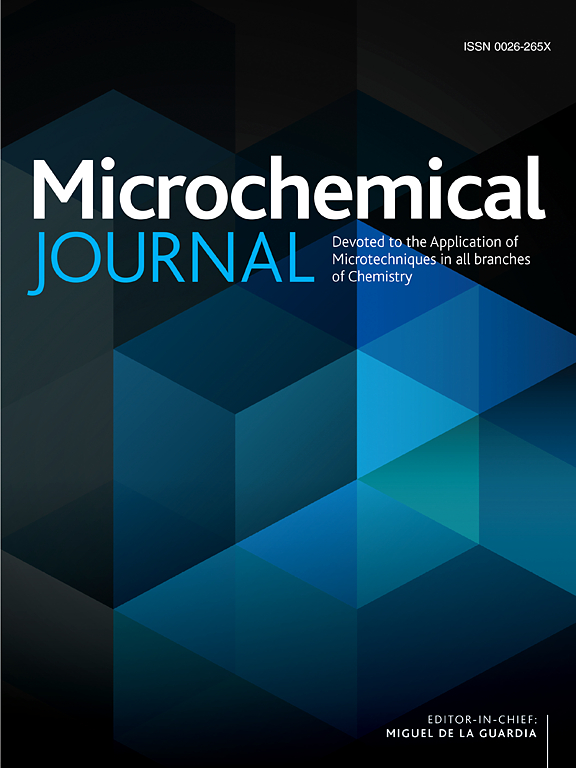基于Pd@PPyC-Bi2S3纳米复合材料的乳酸传感器的线性扫描伏安验证
IF 4.9
2区 化学
Q1 CHEMISTRY, ANALYTICAL
引用次数: 0
摘要
乳酸(LA)的高效和选择性检测在临床诊断、食品质量监测、生物医学实施和环境分析等各个领域具有重要意义。本研究提出了一种创新的电化学传感器探针,利用Pd@PPyC-Bi2S3纳米复合材料(NCs)通过PEDOT:PSS化学粘合剂应用于平面玻碳电极(GCE),用于在环境条件下精确和有针对性地检测LA。利用x射线衍射(XRD)、布鲁诺尔-埃米特-泰勒(BET)、场发射扫描电子显微镜(FESEM)、高分辨率透射电子显微镜(HR-TEM)、紫外可见光谱(UV-vis)和x射线光电子能谱(XPS)等多种技术对Pd@PPyC-Bi2S3纳米粒子进行了超声合成和表征。Pd@PPyC-Bi2S3 NCs/PEDOT:PSS/GCE对LA的氧化表现出优异的电催化性能,具有较宽的线性检测范围(LDR;1.0⁓70.0 μM),检测下限(LOD;0.40±0.02 μM),灵敏度更高(248.48 μM−1 cm−2)。制备的Pd@PPyC-Bi2S3 nc /PEDOT:PSS/GCE传感器探头在面对典型干扰时表现出优异的选择性,适合实际应用。此外,所开发的电化学传感器有效地用于测量不同真实样品基质(如兔血清、大鼠血清和人尿)的LA,证明了其实际有效性。基于Pd@PPyC-Bi2S3 NCs/PEDOT:PSS/ gce的电化学传感器的简单合成,卓越的性能和广泛的适用性使其成为一种非常有前途的分析探针,用于敏感和选择性检测LA,为医疗保健和生物医学领域的安全性做出广泛贡献。本文章由计算机程序翻译,如有差异,请以英文原文为准。

Validation of lactic acid sensor based on Pd@PPyC-Bi2S3 nanocomposites by linear sweep voltammetry
The efficient and selective detection of lactic acid (LA) holds significant importance across the various sectors, such as clinical diagnostics, food quality monitoring, biomedical implementation, and environmental analysis. This study presents the development of an innovative electrochemical sensor probe utilizing Pd@PPyC-Bi2S3 nanocomposites (NCs) applied to a flat glassy carbon electrode (GCE) by PEDOT:PSS chemical binder for the precise and targeted detection of LA under ambient conditions. The Pd@PPyC-Bi2S3 NCs were ultrasonically synthesized and fully characterized by using various techniques, including X-ray Diffraction (XRD), Brunauer-Emmett-Teller (BET), Field Emission Scanning Electron Microscopy (FESEM), High-Resolution Transmission Electron Microscopy (HR-TEM), Ultraviolet–visible Spectroscopy (UV–vis), and X-ray Photoelectron Spectroscopy (XPS). The Pd@PPyC-Bi2S3 NCs/PEDOT:PSS/GCE demonstrated remarkable electro-catalytic performance for the oxidation of LA, featuring an extensive linear detection range (LDR; 1.0 ⁓ 70.0 μM), a lower limit of detection (LOD; 0.40 ± 0.02 μM), and higher sensitivity (248.48 μAμM−1 cm−2). The fabricated Pd@PPyC-Bi2S3 NCs/PEDOT:PSS/GCE sensor probe exhibited exceptional selectivity when faced with typical interferents, rendering it appropriate for practical applications. Moreover, the developed electrochemical sensor was effectively utilized for the measurement of LA across the different real sample matrices, such as rabbit serum, rat serum, and human urine, demonstrating its practical validity. The facile synthesis, exceptional performance, and wide-ranging applicability of the Pd@PPyC-Bi2S3 NCs/PEDOT:PSS/GCE-based electrochemical sensor position it as a highly promising analytical probe for the sensitive and selective detection of LA, contributing to safety in healthcare and biomedical fields on a broad scale.
求助全文
通过发布文献求助,成功后即可免费获取论文全文。
去求助
来源期刊

Microchemical Journal
化学-分析化学
CiteScore
8.70
自引率
8.30%
发文量
1131
审稿时长
1.9 months
期刊介绍:
The Microchemical Journal is a peer reviewed journal devoted to all aspects and phases of analytical chemistry and chemical analysis. The Microchemical Journal publishes articles which are at the forefront of modern analytical chemistry and cover innovations in the techniques to the finest possible limits. This includes fundamental aspects, instrumentation, new developments, innovative and novel methods and applications including environmental and clinical field.
Traditional classical analytical methods such as spectrophotometry and titrimetry as well as established instrumentation methods such as flame and graphite furnace atomic absorption spectrometry, gas chromatography, and modified glassy or carbon electrode electrochemical methods will be considered, provided they show significant improvements and novelty compared to the established methods.
 求助内容:
求助内容: 应助结果提醒方式:
应助结果提醒方式:


